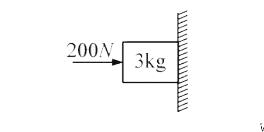A block of mass 20 kg is acted upon by a force F=30N at an angle 53∘ with horizontal in downward direction as shown. The coefficient of friction between the block and the forizontal surface is 0.2. The friction force acting on the block by the ground is (g=10ms2)
40.0 N
30.0 N
18.0 N
44.8 N
The correct Answer is:C
To find the friction force acting on the block, we will follow these steps:
Step 1: Identify the forces acting on the block
The block has the following forces acting on it:
- Weight (W) acting downward: W=mg
- Applied force (F) of 30 N at an angle of 53° downward from the horizontal.
- Normal force (N) acting upward from the surface.
- Frictional force (f) acting opposite to the direction of motion.
Step 2: Calculate the weight of the block
Given:
- Mass of the block, m=20kg
- Acceleration due to gravity, g=10m/s2
The weight of the block is calculated as:
W=mg=20kg×10m/s2=200N
Step 3: Resolve the applied force into its components
The applied force F=30N has two components:
- Horizontal component: Fx=Fcos(53∘)
- Vertical component: Fy=Fsin(53∘)
Calculating these components:
Fx=30cos(53∘)=30×35=18N
Fy=30sin(53∘)=30×45=24N
Step 4: Calculate the normal force
The normal force N is affected by both the weight of the block and the vertical component of the applied force. The equation for the normal force is:
N=W+Fy=200N+24N=224N
Step 5: Calculate the maximum frictional force
The maximum frictional force fmax can be calculated using the coefficient of friction μ:
fmax=μN
Given μ=0.2:
fmax=0.2×224N=44.8N
Step 6: Compare the applied horizontal force and maximum frictional force
The applied horizontal force is Fx=18N and the maximum frictional force is fmax=44.8N.
Since fmax>Fx, the block will not move. Therefore, the frictional force f will equal the applied force:
f=Fx=18N
Final Answer
The friction force acting on the block by the ground is 18N.
---
The block has the following forces acting on it:
- Weight (W) acting downward: W=mg
- Applied force (F) of 30 N at an angle of 53° downward from the horizontal.
- Normal force (N) acting upward from the surface.
- Frictional force (f) acting opposite to the direction of motion.
Given:
- Mass of the block, m=20kg
- Acceleration due to gravity, g=10m/s2
W=mg=20kg×10m/s2=200N
The applied force F=30N has two components:
- Horizontal component: Fx=Fcos(53∘)
- Vertical component: Fy=Fsin(53∘)
Fx=30cos(53∘)=30×35=18N
Fy=30sin(53∘)=30×45=24N
The normal force N is affected by both the weight of the block and the vertical component of the applied force. The equation for the normal force is:
N=W+Fy=200N+24N=224N
The maximum frictional force fmax can be calculated using the coefficient of friction μ:
fmax=μN
Given μ=0.2:
fmax=0.2×224N=44.8N
The applied horizontal force is Fx=18N and the maximum frictional force is fmax=44.8N.
f=Fx=18N
The friction force acting on the block by the ground is 18N.
Similar Questions
A force of 100N is applied on a block of mass 3kg as shown below. The coefficient of friction between wall and the block is 1/4. The friction force acting on the block is :

View SolutionA block of mass 8 kg is sliding on a surface inclined at an angle of 45∘ with the horizontal. Calculate the acceleration of the block. The coefficient of friction between the block and surface is 0.6. (Take g=10m/s2)
View Solution
Knowledge Check
A block of mass 2kg rests on a rough inclined plane making an angle of 30∘ with the horizontal. The coefficient of static friction between the block and the plane is 0.7. The frictional force on the block is
A10.3NB23.8NC11.9ND6.3NA block of mass 3 kg rests on a rough inclined plane making an angle of 30∘. With the horizontal. The coefficient of static friction between the block and the plane is 0.7. The frictional force on the block is
A9.8 NB0.7×9.8×√3 NC9.8×√3 ND0.7×9.8 N
A block of mass 8 kg is sliding on a surface inclined at an angle of 45∘ with the horizontal . Calculate the acceleration of the block . The coefficient of friction between the block and surface is 0⋅6 ( Take g = 10m/s2)
View SolutionA block of mass 2kg rests on a rough inclined plane making an angle of 30∘ with the horizontal. The coefficient of static friction between the block and the plane is 0.7. The frictional force on the block is
View SolutionA block of mass 1 kg is placed on a truck which accelerates with acceleration 5ms−2. The coefficient of static friction between the block and truck is 0.6. The frictional force acting on the block is
View SolutionA force of 200N is applied as shown in the figure on block of 3 kg. The coefficient of friction between the block and the wall is 0.3. Find the friction acting on the block. (in N) {Take g = 10 m/s2

View SolutionA force of 100 N is applied on a block of mass 3 kg as shown in figure. The coefficient of friction between the surface and the block is 14 .Then the friction force acting on the block is

View SolutionA horizontal force of 10 N is necessary to just hold a block stationary against a wall. The coefficient of friction between the block and the wall is 0.2. the weight of the block is (g=10m/s2)

View Solution
